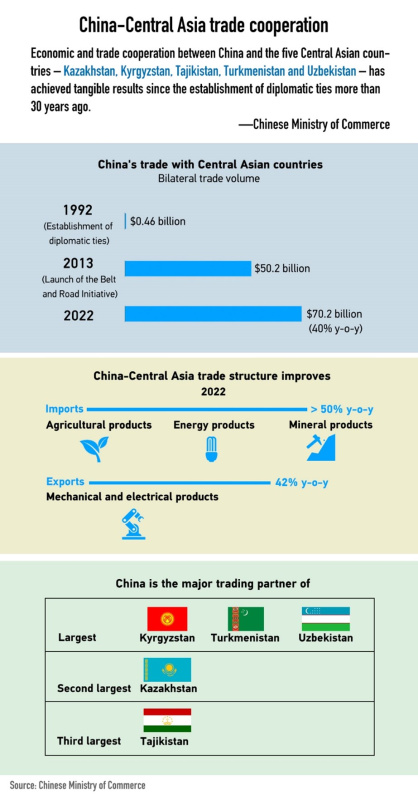
China's economic and trade cooperation with the five Central Asian former Soviet states has achieved tangible results since diplomatic relations were established more than 30 years ago, China's Ministry of Commerce said at a press briefing.
China’s trade with the five countries – Kazakhstan, Kyrgyzstan, Tajikistan, Turkmenistan and Uzbekistan – increased to $70.2 billion in 2022 from $0.46 billion in 1992, when China established diplomatic ties with the five Central Asian countries.
China is the largest trading partner of Kyrgyzstan, Turkmenistan and Uzbekistan, and the second largest trading partner of Kazakhstan, as well as the third largest trading partner of Tajikistan, according to the Ministry.
The bilateral trade volume saw a 40-percent growth from a year ago. It maintained a strong development momentum, and recorded a year-on-year expansion of 22 percent in the first quarter of this year.
The trade structure has improved over the years. Last year, China’s imports of agricultural, energy and mineral products from the five countries jumped over 50 percent from a year earlier, while exports of mechanical and electronic products to them increased by 42 percent.
Investment cooperation has also benefited all sides. As of the end of March 2023, China’s direct investment stock in the five Central Asian countries stood at over $15 billion. The cumulative turnover of completed projects reached $63.9 billion.
A batch of cooperation projects have been launched in the fields of infrastructure, oil and gas exploration, manufacturing, medical and health care, education, technology and the digital economy.
China and all the five central Asian countries have signed cooperation documents on the joint construction of the Belt and Road Initiative. There are some landmark projects, such as the Horgos International Border Cooperation Center and China-Central Asia gas pipeline.
The Horgos International Border Cooperation Center is the first trans-border international free trade zone in the world and China’s first special economic zone being “within the country, but out of the jurisdiction of its customs.”
Running through Turkmenistan, Uzbekistan and Kazakhstan, the China-Central Asia gas pipeline is China’s first transnational gas pipeline. By the end of 2022, the pipeline had delivered a total of 423.2 billion cubic meters of natural gas to China since it began operation in 2009.
The pipeline has effectively promoted the social and economic development of countries along the route, and played an important role in the diversification of China’s energy imports and the improvement of domestic energy consumption structure.
The assembly center of China-Europe Railway Express in Xian has 17 mainlines from the city to Central Asia countries, which has become the golden channel for two-way logistics in China and Central Asia.
China has established a comprehensive strategic partnership, advanced the building of a community with a shared future for mankind at the bilateral level, and signed the Belt and Road Initiative (BRI) cooperation documents with all five Central Asian countries.
The latest milestone took place in January this year, when China and Turkmenistan elevated the bilateral relationship to a comprehensive strategic partnership, reached a consensus on advancing the building of a China-Turkmenistan community with a shared future, and signed agreements on cooperation under the framework of the BRI and cooperation in other fields.
Thirty-one years ago, China took the lead in establishing diplomatic ties with the five Central Asian countries – Kazakhstan, Kyrgyzstan, Tajikistan, Turkmenistan and Uzbekistan, opening the door to bilateral exchanges and cooperation.
Over the past 31 years, China and Central Asian countries have blazed a new trail of good-neighborly friendship and win-win cooperation and set a good example of fostering a new type of international relations.
The C+C5 cooperation mechanism, a new mechanism established for promoting cooperation between China and Central Asian countries, has provided an important platform for deepening all-round cooperation between them.
Last month, the fourth C+C5 Foreign Ministers’ Meeting, chaired by State Councilor and Foreign Minister Qin Gang, was held in northwest China’s Xian, a city with over 3,100 years of history, and known as the starting point of the ancient Silk Road that went through Central Asia to Europe. The meeting yielded a consensus as they agreed to adhere to mutual benefit and win-win results, advance high-quality Belt and Road cooperation and expand security cooperation.
When meeting with Qin last month, Kazakhstan’s Deputy Prime Minister and Foreign Minister Murat Nurtleu said that the strategic partnership with China remains one of the priorities of Kazakhstan’s foreign policy. Nurtleu highlighted the need for joint efforts to implement the agreements reached at the highest level to expand multifaceted cooperation between the two countries, particularly in trade and investment.
The C+C5 foreign ministers’ meeting was launched in 2020 and has been held annually since then in a bid to bring mutual trust and cooperation between the two sides to the next level.
The first C+C5 Summit will be held on May 18 and 19 in Xian.
Being the first offline summit between leaders of the six countries since the establishment of diplomatic relations 31 years ago, the summit is of milestone significance to China’s ties with the five Central Asian nations, said Wang Wenbin, spokesperson of the Chinese Ministry of Foreign Affairs, at a Monday briefing.
Central Asia is where the “Silk Road Economic Belt,” the land part of the BRI, was first proposed. Upholding the principle of extensive consultation, joint contribution, and shared benefits, China and Central Asian countries have empowered the BRI to bear rich fruits in Central Asia, bringing tangible benefits to the local people of the region.
“The BRI has brought China and the five Central Asian countries even closer. The upcoming China-Central Asia Summit will further guide the six countries to continue the friendship and deepen cooperation, jointly building the China-Central Asia community with a shared future,” said Yu Xiaoshuang, an assistant researcher at the China Institute of International Studies.
Reported on May 15/16 by CGTN (China).